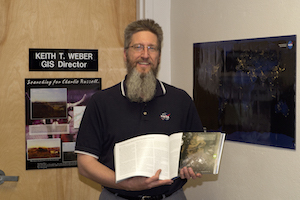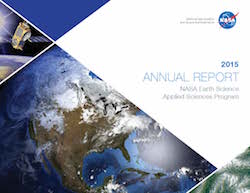ISU RECOVER wildfire-fighting tool recognized by NASA again; two stories featured in 2015 Annual Report for NASA Earth Science Applied Sciences Program
July 22, 2016
POCATELLO – The National Aeronautics and Space Administration (NASA) has again recognized a geographic information system (GIS)-based wildfire recovery and decision-support program developed by Idaho State University and NASA.
 Since 2011, ISU and the NASA have been working on the Rehabilitation Capability Convergence for Ecosystem Recover (RECOVER) project, designed for use in rapidly planning the recovery of wildfires. It is also proving useful in fighting active wildfires, and is being used on active fires this summer.
Since 2011, ISU and the NASA have been working on the Rehabilitation Capability Convergence for Ecosystem Recover (RECOVER) project, designed for use in rapidly planning the recovery of wildfires. It is also proving useful in fighting active wildfires, and is being used on active fires this summer.
In the 2015 Annual Report by the NASA Earth Science Applied Sciences Program released this month there are two stories about the RECOVER system. Those stories are “Taming the Inferno: A pioneering system is using satellites to expedite wildfire recovery—while the fires still rage,” and “Sparking a Movement: Spreading satellite-based strategies for wildland fire management.”
“It’s really nice to have your work recognized nationally,” Weber said. “This is not something we see very often in the fields of science and technology.”
Using RECOVER, it takes a few minutes for Bureau of Land Management or other agency wildfire managers to produce a detailed report that gives them the information needed to plan for recovery following a wildfire or to use the system to fight active fires.
NASA also featured the RECOVER project this spring in its premier annual publication featuring, “Spinoff,” which features successful NASA technologies. The RECOVER program was detailed in the article “Software Helps Restore Fire-Ravaged Habitats.”
“The number of users is growing all the time,” said Keith Weber, director of the ISU GIS Training and Research Center and the principal investigator on the project “and we now have seen RECOVER used not only in Idaho, but in California and Oregon as well”.
 For the 2016 wildfire season, users can better use their mobile devices to interact with the system while they are out in the field. They can use RECOVER maps on their phones and electronic notebooks while on site at a fire, or use their mobile devices to record data from the field to update web-based RECOVER maps and fire models.
For the 2016 wildfire season, users can better use their mobile devices to interact with the system while they are out in the field. They can use RECOVER maps on their phones and electronic notebooks while on site at a fire, or use their mobile devices to record data from the field to update web-based RECOVER maps and fire models.
RECOVER also offers a new web interface to end-users. Thus, its users – such as the BLM, Idaho Department of Lands, California Department of Transportation, or National Weather Service – can initiate their own RECOVER web maps on the Internet 24/7 without having to contact either ISU or NASA.
Accessibility and security for the system have also been improved and new data sets are available. The new data sets include in-depth information highlighting steep slope area and even provide fire managers with maps developed by colleagues at the University of Arkansas and Michigan Tech University detailing the likelihood of landslides and debris flows following wildfires.
NASA also featured RECOVER this spring in its premier annual publication “Spinoff,” which features successful commercialized NASA technologies.
To view the full article on RECOVER in 2015 Annual Report by the NASA Earth Science Applied Sciences Program visit: http://appliedsciences.nasa.gov/system/files/docs/AnnualReport2015.pdf.

